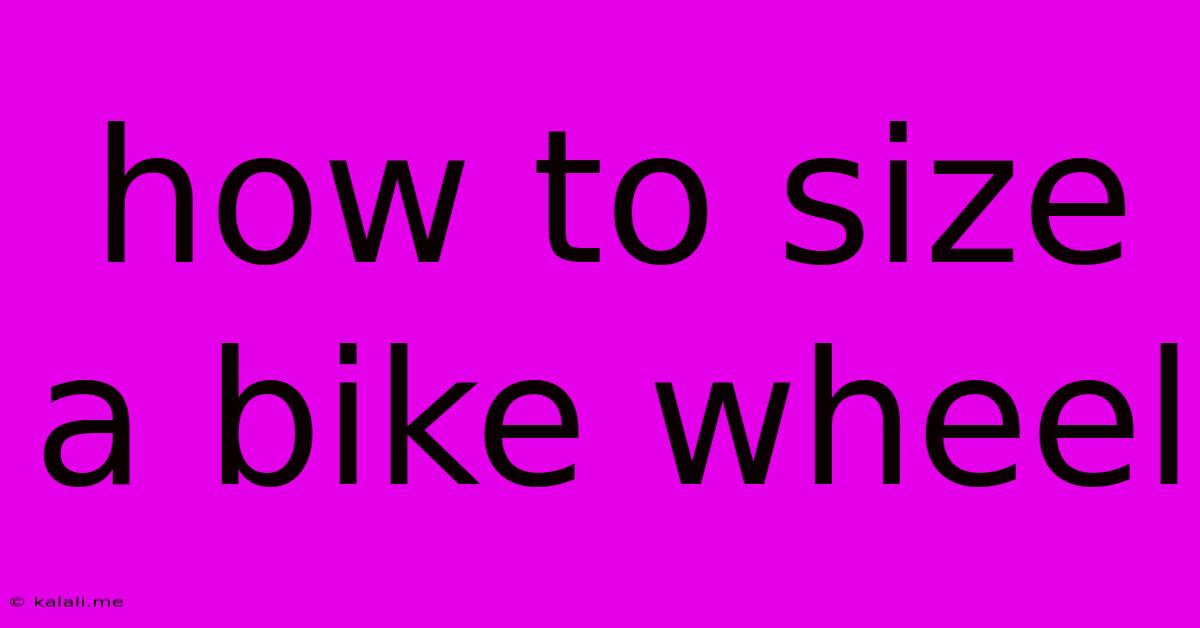How To Size A Bike Wheel
Kalali
May 31, 2025 · 3 min read

Table of Contents
How to Size a Bike Wheel: A Comprehensive Guide
Finding the right size bike wheel can feel overwhelming, especially with the variety of sizes and standards available. This comprehensive guide will break down everything you need to know to ensure you select the perfect fit for your bicycle, enhancing both performance and safety. Understanding wheel sizing is crucial for proper bike fit, optimal performance, and avoiding costly mistakes.
Understanding the Key Measurements:
Bike wheels aren't simply sized by diameter; several crucial measurements determine compatibility with your bike frame. These include:
- Wheel Diameter (in inches or millimeters): This is the overall diameter of the wheel, measured from one side to the other, including the tire. Common sizes include 26", 27.5", 29", and 700c (which is roughly equivalent to 29"). The most common method for determining this is to simply measure the existing wheel.
- Rim Diameter (ERD): Effective Rim Diameter (ERD) is the crucial measurement for determining wheel compatibility with your hub. This measurement determines the length of the spokes required to correctly lace the wheel. It's always best to check the manufacturer's specifications for your hub to ensure a perfect fit. You will usually need to use the ERD for ordering replacement spokes for wheel builds.
- Rim Width (Internal and External): Rim width plays a crucial role in tire compatibility and ride quality. Internal rim width refers to the distance across the inside of the rim, while external rim width is the distance across the outside. Matching these with the correct tire size is essential for optimal performance and safety. The internal width will be crucial in determining which tires will fit your wheel securely.
- Tire Size: Although not a wheel measurement, your tire size interacts intimately with the wheel and is critical to proper sizing. Understanding the tire size, usually shown as a number like 26 x 1.95, is essential to ensuring your selected tire works with your wheel and frame clearance.
- Number of Spokes: The number of spokes affects the wheel's strength, weight, and stiffness. While 32 and 36 spokes are common, other configurations exist. You should ensure your new wheel will be compatible with the number of spokes your hub accepts.
Methods for Determining Your Wheel Size:
There are several ways to determine the correct wheel size for your bike:
- Check Your Existing Wheel: The easiest method is to examine your current wheel. The size is usually printed on the sidewall of the tire, the rim itself, or printed on the wheel. This is often your best starting point.
- Consult Your Bike's Manual: Your bike's owner's manual should specify the recommended wheel size. If you no longer have this manual, you can often find this information online on the manufacturer's website.
- Measure Your Wheel: If all else fails, you can carefully measure the diameter of your existing wheel. Remember to measure accurately and account for tire thickness. You will need to account for the tire size to achieve a measurement to verify compatibility.
- Check Your Bike Frame: Certain frame types are compatible with specific wheel sizes. For example, mountain bikes often use 26", 27.5", or 29" wheels, while road bikes commonly use 700c wheels. While the wheel size will often be implied, confirming this with your frame will allow you to verify your current sizing.
Common Mistakes to Avoid:
- Ignoring ERD: Using the wrong ERD will result in improper spoke tension and can cause wheel failure.
- Mismatching Rim and Tire Width: Using a tire that is too narrow or too wide for the rim can lead to poor handling and safety concerns.
- Ignoring Frame Clearance: Ensure your new wheel and tire combination have enough clearance within your bike frame to avoid rubbing.
Conclusion:
Choosing the right bike wheel involves more than just diameter. Understanding the various measurements—diameter, ERD, rim width, tire size, and the number of spokes—is crucial for proper fit, optimal performance, and safety. By following the steps outlined in this guide, you can confidently select the perfect wheel for your bicycle. Remember, when in doubt, consulting a professional bike mechanic is always recommended.
Latest Posts
Latest Posts
-
Mac M2 Logs Out Randomly And Finder Folders Disa
Jun 01, 2025
-
A Group Of Men And Women
Jun 01, 2025
-
How Did Gibbs Get Boat Out Of Basement
Jun 01, 2025
-
What Is The Best Repellent For Cicadas
Jun 01, 2025
-
What Is A Positive Divided By A Negative
Jun 01, 2025
Related Post
Thank you for visiting our website which covers about How To Size A Bike Wheel . We hope the information provided has been useful to you. Feel free to contact us if you have any questions or need further assistance. See you next time and don't miss to bookmark.